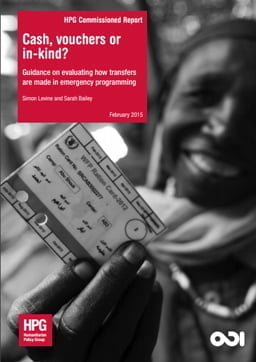Cash, Vouchers or In-Kind? Guidance on Evaluating How Transfers are Made in Emergency Programming
In humanitarian settings, aid agencies often assist populations by transferring resources, usually using cash, vouchers or in-kind aid, such as food rations, shelter materials, seeds and tools and kits of household items. The use of cash or vouchers to replace in-kind aid is most pronounced in food assistance programming, but it is increasingly being considered for emergency shelter, education and many other kinds of programming. Several manuals and reports discuss the relative advantages and disadvantages of providing aid in-kind, giving recipients cash that they can use to meet their needs as they think best, or giving them some form of voucher, which makes the assistance available through a local market system but restricts to some degree what recipients can buy or where they can make their purchases.
The choice of how to transfer assistance – whether through in-kind aid, cash or vouchers – to people in crises may be an important decision. In order to constantly improve practice, the humanitarian community needs evidence about the diverse impacts of different choices. In order to ensure that the best decisions are made, evidence is also needed about the decision-making processes that lead to these choices. However, evaluations of these interventions have rarely examined this choice, and no explicit guidance exists for evaluators on how to examine the decision or the decision-making process. This guidance is a first attempt to fill that gap, with the aim both of encouraging evaluators to give more explicit attention to the choice of transfer and also providing some assistance on how this can be examined.
